Formula 5000
Open Wheel Racers at Road America
Origins of F5000
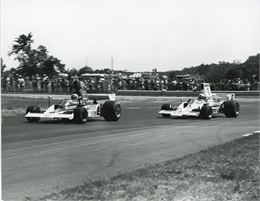
Al Unser Sr. (car 51) leads Brian Redman (car 1) at turn 5 during the 1975 F5000 Championship race at Road America. Photo by Patrick Unger. Courtesy of Road America Archives.
By the 1960s, the time was ripe for fast, big-engine, open-wheel formula cars. In 1965, the SCCA inaugurated a single-seat, open-wheel Formula A race series with engines up to 3-liter in size. But with the development of powerful, lightweight, relatively inexpensive V8 engines by Chevy, Ford, and Dodge, Formula A was soon revised to include engines up to 5 liters. Cars were built by the top manufacturers of the time, such as Lola, McLaren, Eagle, and Shadow, and the race series would become known as Formula 5000 (F5000). Top drivers such as Mario Andretti, David Hobbs, and Brian Redman took the wheel of these powerful race cars.
The SCCA soon introduced a professional Formula A race series, known as the Grand Prix Championship. Names changed over the years to SCCA Continental Championship, then to SCCA L&M Continental Championship, and finally, to the SCCA/USAC Formula 5000 Championship. This popular series competed at Road America from 1968-1976, often combined with the Trans-Am series.
First Formula Races at Road America
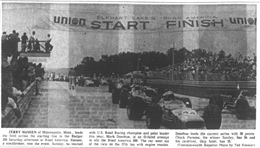
Jerry Hansen (car 44) was on pole for Road America’s first F5000 race. Photo by Ted Kreamer, Fond du Lac Reporter, July 29, 1968.
Road America’s first Formula A Grand Prix Championship was the 1968 Badger 200. The field consisted of fourteen cars. Jerry Hansen, a Minneapolis stockbroker and frequent competitor at Road America, scored the top qualifying time in his Lola T-140-Chevrolet. Hansen won the race with an average speed of 98.160 mph.
In 1969, Formula A was advanced to a feature Road America event replacing the iconic Road America 500. The field had more than doubled, attracting over 31 cars. Road America President Clif Tufte exclaimed to the Sheboygan Press: “Just about every ‘A’ in the country must be coming!”
Wanting the new race to live up to the RA500’s legacy, Tufte organized the event as a 300 mile endurance race. This made Road America's race the longest of the series. But there was a problem. Formula cars were designed for sprints. They only carried enough fuel for 120 miles and were not set up to be refueled mid-race. Tufte’s solution was simple: break the race down into three 100-mile heats. Statisticians aggregated the results to determine the winner. As a result, Tony Adamowicz in an Eagle Mk 5 Chevrolet finished fourth, second, and first in the three heats, and was proclaimed the aggregate winner. The three heat format was highly disliked by drivers and fans.
Changing Formats

John Cannon in a McLaren M10B-Chevrolet takes the victory lap after winning Road America’s 1970 F5000 SCCA Continental Championship race. Photo by Gordon Means. Courtesy of Road America Archives.
The three-heat format was dropped in favor of a 100-mile sprint in 1970. in the new sprint, John Cannon beat David Hobbs by a car length, averaging 106.352 mph. Hobbs however set set the fastest lap of the day at 2:12.9, 108.901 mph. Format changed again in 1971 and 1972 when SCCA regulations stipulated race results would be an aggregate of two heats. With the two combined heats, David Hobbs won in 1971 and Grahm McRae won in 1972. Format changed again in 1973, with two qualifying heats and a 100-mile final race for the top contenders. This format would remain through the end of the series.
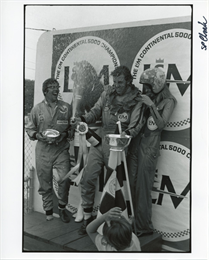
After winning the 1971 Road America SCCA L&M Continental 5000 Championship race, David Hobbs pops the champagne in celebration with Miss Road America Kathy McDermott. Hobbs went on to win the F5000 championship that year. Photo Courtesy of Road America Archives.
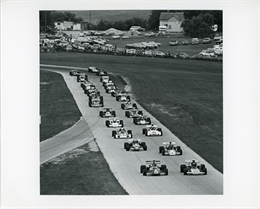
F5000 cars round turn 14 during the pace lap for the 1972 SCCA L&M Continental 5000 Championship. Courtesy of Road America Archives.
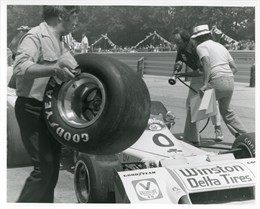
Tires are quickly changed on Jody Scheckter’s Trojan T-101 F5000 car during the 1973 SCCA L&M Championship. Scheckter placed second in the Road America race but went on to win the series that year. Scheckter later became the Formula 1 World Champion in 1979. Photo by Jack Jordan. Courtesy of Road America Archives.
Indy Cars enter a F5000 Race
Tony Settember (driving a F5000 car) rounds a corner at Road America in 1974. Photo by Bill Jennaro. Courtesy of Road America Archives.
In 1974, USAC partnered with the SCCA to sanction the Formula 5000 series. This opened the F5000 to Indy cars, and three Indy cars entered the 1974 race. However, Indy cars, which had different specifications, proved uncompetitive when competing alongside F5000 specification cars on the demanding Road America course. Although Indy cars were incredibly fast on the straights, they were unable to take the course’s many corners at competitive speeds. Quickly realizing it was not practical, all three Indy car drivers retired from the 1974 race by the 9th lap.
Andretti and Redman Rivalry
Mario Andretti in car 5 leads starting lap of the 1975 F5000 Race followed by B. J. Swanson in car 42; David Hobbs, car 10;, and Eppie Wietzes, car 94. Races at Road America attracted the world’s top drivers. Andretti won the 1969 Indy 500 and would go on to become the 1978 Formula 1 World Champion as well as win the 1984 PPG Indy Car World Series. Photo courtesy of Road America Archives.
The 1974 race between Mario Andretti and Brian Redman was one of the closest F5000 races ever. Andretti, racing a Lola T332 Chevrolet, had won the first heat, setting a new F5000 lap record of 2:04.741, averaging 115.440 mph. Then, Redman won the second heat in his Lola Chaparral 5000. During the feature race Andretti and Redman continuously dueled, with Andretti often leading by a hair. On the final lap, Andretti’s car started to run out of fuel. So focused on the fuel gauge Andretti briefly left the track rounding turn 12. Andretti said “[I was] so concerned with my fuel gauge I wasn’t concerned with where I was going at the end...” Andretti recovered and crossed the finish line a mere eight tenths of a second ahead of Redman. The win tied Andretti with Redman in points toward the championship, but Redman would go on to three more wins that year and become the 1974 series champion.
A rematch seemed inevitable in 1975. Unfortunately Redman suffered last minute mechanical problems and Andretti easily won the 1975 Road America F5000 16.6 seconds ahead of the next competitor, Jackie Oliver.
The Year with Two F5000 Races
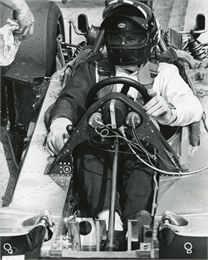
Jackie Oliver getting into the tight quarters of the Shadow DN6 in preparation for the 1976 Road America F5000. Photo by Patrick Unger. Courtesy of Road America Archives.
In planning the 1976 season, Tufte scheduled two F5000 events at Road America. The first was the regular championship held in July. A second independent F5000 event was booked six weeks later in August. Little did fans know that the two events would be the last F5000 races at the track.
The July F5000 race proved to be very competitive. The feature saw Danny Ongais, Al Unser, Vern Schuppan, Brian Redman, and Jackie Oliver all take the lead at some point. At the end Oliver won in his Dodge-powered Shadow DN6 at an average speed of 102.59 mph.

Jackie Oliver at turn 5 on his way to victory in his Dodge-powered Shadow DN6 at the 1976 SCCA/USAC Formula 5000 Championship at Road America. Photo by Schreiber. Courtesy of Road America Archives.
The August F5000 event was not part of the Championship, but gave fans a second chance to see F5000 cars and drivers compete at Road America. Almost all the cars and drivers returned. Officially known as the "Road America Speedster" the race was organized as a handicap. A staggered start was used to equalize the competition.
Australian Vern Schuppan, driving an AAR Lola, took the win. Surprisingly, Schuppan didn't know how well he was doing for most of the race. Schuppan told a reporter: "All I knew is that when I passed the pits, the sign would come out telling me how many seconds I was behind the car in front of me. I'd pass a couple of cars and think I was in front. Then I'd go past the pits and I'd see the sign that I was so many seconds behind another car. It wasn't until I passed No. 74 [Rich Shirley, who led since lap four] that I new I was chasing anybody." Thus ended the last F5000 series race at Road America.
Driver Brian Redman enjoys an ice-cream bar, just like any of the thousands of spectators, as his Lola T332C is prepped for the August 1976 Road America Speedster Race for F5000 cars. Photo by Tom Kelly. Courtesy of Road America Archives.
The F5000 series abruptly ended in 1976 when USAC pulled out of the series at the close of the season. Nonetheless, the F5000 Championship races at Road America had been a success, consistently drawing crowds of 31,000 spectators or more each year.
Despite it's end, the F5000 series left a remarkable legacy. New regulations in 1977 resurrected former F5000 cars, albeit with entirely different bodywork in the SCCA’s revived Can-Am series. The cars lived on.
Furthermore, USAC’s involvement in the F5000 series foreshadowed Indy car regulations that would eventually bring Indy cars to compete on road courses like Road America. It would only be a few years until CART Indy cars became part of a series that would come back to Road America and evolve into today’s IndyCar.
[Sources: Interview with Road America staff Tim Kemmis, Spring 2023. Schultz, Tom. Road America: Five Decades of Racing at Elkhart Lake. Indianapolis, IN: Beeman Jorgensen Inc., 1999; Schultz, Tom. Celebrating 50 Years of Road Racing. Elkhart Lake, WI: Road America, 2004; "Open-Wheel, Big-Engine Racers (Not Sports) At Elkhart Lake In July." Sheboygan Press, March 13, 1968; "Jerry Hansen of Minneapolis, Minn leads the field..." Fond du Lac Commonwealth Reporter, July 29, 1968; "Record Turnout Of Cars In RA Continental 500." Sheboygan Press, July 18, 1969; "3-Heat '500' Sunday." Sheboygan Press, July 19, 1969; "Elkhart Lake First 'Real' Indy-SCCA Confrontation." Sheboygan Press, July 24, 1974; "$75,000 Road America Weekend 'Set to Go" Sheboygan Press, July 26, 1974; Pelkin, Dwight. "Andretti Split-Second Winner." Sheboygan Press, July 29, 1974;"Redman, Unser Fastest Road America Drivers." Sheboygan Press, July 24, 1976; Pelkin, Dwight. "Oliver Wins RA5000 With Late-Lap Charge." Sheboygan Press, July 26, 1976; "Schuppan finds he's winner." Fond du Lac Reporter, August 30, 1976; "Aussie Schuppan Wins Elkhart Lake Handicap Event." Capital Times, August 30, 1976.]



